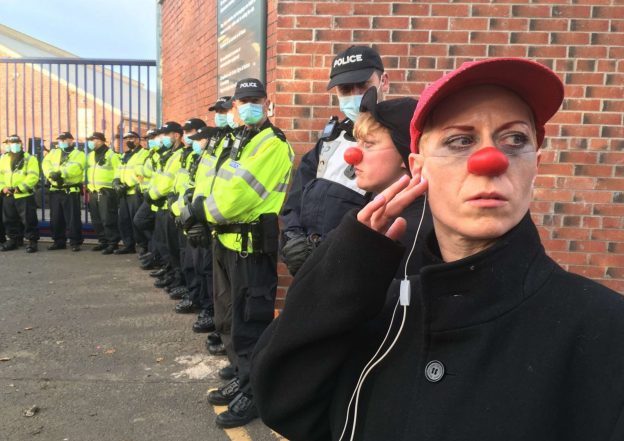Send In the Clowns! Don’t worry, they’re here…
A fire ritual, a walking bus and an arresting image are, for Robyn Hambrook, the unlikely stepping stones to a career journey that has spanned community fire festivals, ritual theatre, street arts, circus, clowning and protest.
I am watching the absurd spectacle of a group of clowns, dressed as cops, undress in front of an unwilling audience of policemen. This is a moment when you might ask yourself, ‘how the hell did I get here?’
I am on a hill in the centre of Edinburgh. A handmade black cloak, fleece lined, covers my near-naked body, which is painted in red, orange and yellow, to symbolise the element of fire. I stand with other performers watching as the first flame is blown to life in tinder. This will light all the fires on the hill: sculptures, torches, fire-toys and brands. It is Calton Hill, in the centre of the city, at 9pm on 30 April 2001. The first drum beats ring out across the hill and the May Queen and her White Women Army rise up slowly on the Acropolis. They bow to the four directions marking the start of the ritual, before descending from the giant monument to circle around the hill. The May Queen, followed by her procession of White Women, Drummers and Fire Guard, pass beneath a five metre high Fire Arch, symbolising their entry into the underworld. From here the Queen will circle the hill where she encounters the four elements – air, earth, water, fire – bringing order to chaos, after the winter. I am part of Fire Point.
This is the Beltane Fire Festival, a modern and dynamic reinterpretation of the Iron Age Celtic ritual. Since 1988, an eclectic group of volunteer performers have come together each year to collectively create a carnivalesque, ritual performance that welcomes the start of summer. It is visually stunning, incorporating a procession, drumming, dance, fire and sculptural costumes; exploring themes of death and resurrection and attracting audiences of up to 10,000.
That was the first of ten years that I participated in this ritual community celebration, the largest of its kind in the world. There is potency and power in this wild spectacle that surpasses theatre. It is a rite of passage for many participants in the container of a theatre-making process and performance. The ritual ties us to the living world. Each festival marks the passage of time. Every freezing, muddy, rain-swept rehearsal in the Meadows and on the hill in March and April keeps us in deep connection to the earth and the changing seasons. I also truly believed our ritual could move weather patterns and bring the summer and the promise of warmth to Scotland.
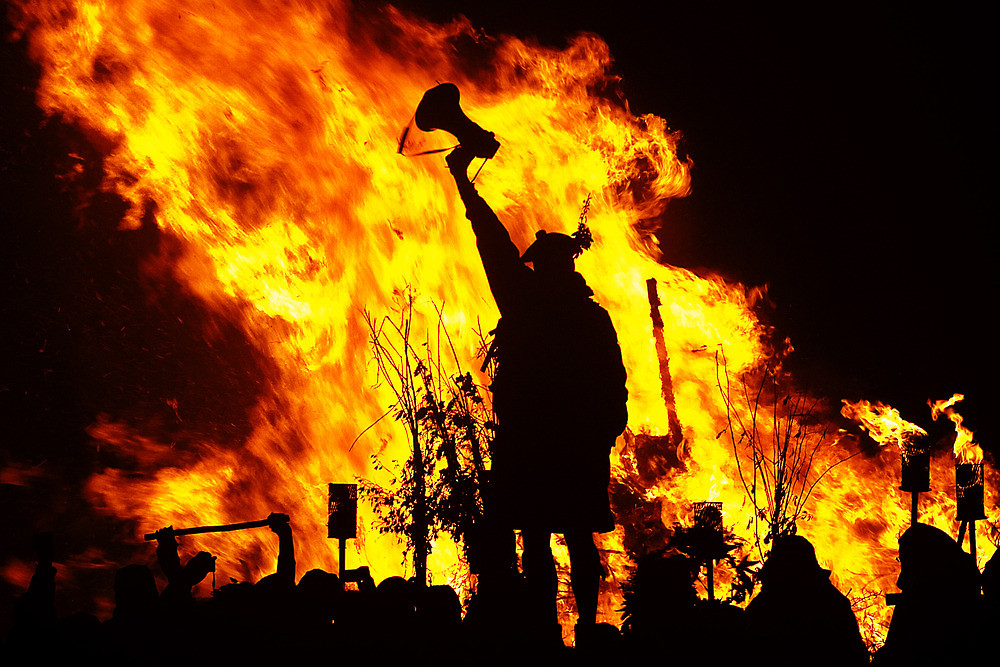
In both ritual and the carnivalesque, the border between the audience and the performer dissolves. Russian Theorist Bakhtin says: ‘Carnival is not a spectacle seen by the people; they live in it, and everyone participates because its very idea embraces all the people. While the carnival lasts, there is no life outside it.’ We enact the Beltane Fire Festival with and for the people of Edinburgh. There is no demarcated space for the audience. The ritual moves through them, with them. We all cheer when the Green Man is resurrected. His new life is for all of us.
This inbetween space is hugely exciting to me. A place to dance on the edges of spirituality, performance, ritual and life.
I am on a bus… of sorts. It’s The Feetbus; a street performance sold as ‘your festive transport solution’. The six-metre long frame of a bus is made with lightweight aluminium; with sides, a roof and a door of stretched vinyl. There are no wheels: you can see the marching feet of the passengers beneath. Inside, four performers, one on each corner, have a harness that keeps the structure lifted up. They are the Driver, Navigator and two ‘Back Wheels’. The Festive Transport Personal Care Assistant (FTPCA) opens the door and invites the passengers/audience into the bus to enjoy the zero-emissions festive transport.
The FTPCA runs through the safety features of the bus: ‘You can find emergency exits here, here and here’, pointing to the space beneath the bus frame. ‘To use this exit simply stop, drop and roll to get out.’
The driver then practises some driving manoeuvres with the passengers, including reversing to a chorus of audience beeps, and a ‘doughnut’, where the whole bus spins wildly on the spot, arms waving out the windows while everyone screams.
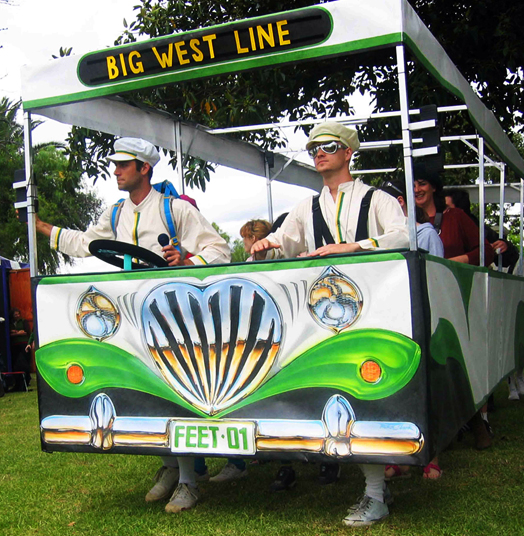
In 2005 I had left a safe yet unsatisfying job in corporate events management in Auckland, to move to Melbourne. I answered a crazy invitation from a friend to take this walking bus around the world. In 2006 we toured The Feetbus around Australia, then to the UK, France, Austria, Hungary, and Romania – providing festive transport for hundreds of passengers at music, arts, theatre and street festivals.
The bus framework physically and metaphorically allowed us to explore political, social and environmental themes. We used the ‘doughnut’ manoeuvre to represent a revolution by the people (instigated by the Back Wheels) to overthrow a Dictator (the Driver). Zero-emissions messaging could support environmental campaigns and promote a green message. And a decadent bus tour became a weird social experiment about greed and coercion, in which we turned all our passengers into pigs and then sold them to a farmer for bacon.
Audiences entered the game of ‘being on the bus’. Through this playful contract we encouraged audiences to participate in the process of change. This work still inspires how I view and make street theatre now. Audience participation is key. A game is vital. And so is the location. I love the street: a place to reach people who are unfamiliar with theatre and where dynamic relationships and playful conversations can occur.
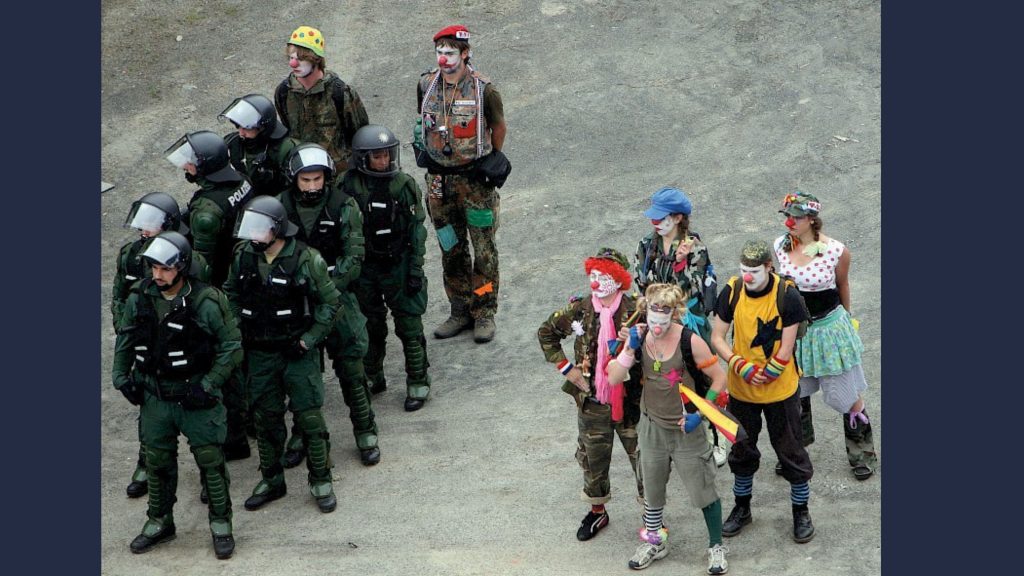
I am doing a Masters in Directing Circus at Circomedia in Bristol. My final major project is called ‘Small Circus Acts of Resistance’ exploring the intersections of circus and protest. I find the spirit of resistance contained in many aspects of circus. Take, for example, the skills of aerialists and funambulists, which can be seen as a protest against gravity that would keep us firmly on the ground. Or the counter-cultures that circus embraces, such as sideshow freaks and the nomadic and alternative ways of living intrinsic to the circus life – all resisting societal norms.
While researching examples of circus in street theatre and outdoor arts, I discover the protest pageantry of Bread and Puppet Theatre and the absurd situationist interventions of the Youth International Party (more commonly known as The Yippies), such as their attempt to levitate the Pentagon. I am drawn to the spectacle and subversive humour in these examples, reminding me of my own playful street theatre experiences. Here I find the compelling potential for resistance in one particular act in the circus, the clown.
I keep researching and a single image stops me in my tracks. Reproduced numerous times in press, in books and online, it shows a group of clowns, dressed in a combination of army fatigues with brightly coloured trimmings and garish make-up standing next to a group of riot cops. This is the Clandestine Insurgent Rebel Clown Army, also known as CIRCA or just the Clown Army. A form of nonviolent direct action, they appeared in protest spaces from 2004-06. Their imitation of authority, the army and police playfully and simply ridicules by association. With one stroke, one image highlights the radical power of humour in the face of oppression. Images like these are ‘irresistible’ according to LM Bogad, one of the original members of the Clown Army. These are ‘images that are so compelling that our ideological opponents (the media) cannot help but reproduce them even though they undermine their worldview and support ours’.
This irresistible image has also led me on my current research journey. I managed to track down the co-founders of the Clown Army, Jay Jordan and Hilary Ramsden, and together we have organised Trickster Laboratories, in Bristol and Glasgow, inviting artists, activists and clowns to research clowning as a form of creative activism.
A single image has inspired my conversations with international clown activists, like Sabine Choucair from Lebanon, whose company Clown Me In, uses clowning to spread laughter and provide relief to disadvantaged communities in times of crisis. It has led to collaborations with international tricksters, The Yes Men, who use humour, spoofs and pranks to highlight the corporate takeover of society. Their elaborate ‘political hoaxes’ include impersonating a Dow Chemical spokesman on BBC, reminding the world that Dow had never properly taken responsibility for or compensated victims of a gas leak at their pesticide plant in Bhopal in India.
This arresting image also inspired me to lead ten clowns, dressed as cops, to the streets of Glasgow during the Climate Conference (COP26) in response to the massive over-policing of the event. The Clown Cops carried out police drills, manoeuvres and inspections in front of a line of policemen stationed outside the Ministry of Defence where a peaceful Extinction Rebellion protest ended. When the Clown Cops manoeuvres descended into a strip show, the police found themselves the unwilling audience to this absurd spectacle that mocked their position and power.
Bold, brash and playful, the clown navigates a liminal space, the edge between authority and protester, slipping easefully between parody, performance, protest and play. They radicalise oppressive spaces through laughter and ridicule. Clowning has given me a compelling and exciting way to express my anger and frustration with the state of the world. And a way to bring my passion for street theatre, circus and clowning in alignment with my political voice. The ritual and carnivalesque practices of the Beltane Fire Festival and the participatory playful antics of The Feetbus could feed new radical forms of direct action.

Tools of the Activist Clown
Over five years of research I have been collating a compendium of Tools of the Activist Clown. These are things the clown is and does that can be useful for our political endeavours – as commentators, activators, and change-makers. The growing list includes things like disruption, confusion, transgression, play, pleasure, collaboration, ridicule, and mockery.
Here are some examples of some of these dynamics and how I explore them with participants in workshops, in the street and in protests.
The Yes of Clowning
Clowns say ‘yes’. This is basic theatre training. We use it in improv, we use it in devising. Instead of getting heady, or coming up with reasons why not or an even better idea, we just say yes. And try it.
‘Let’s all be chickens!’ yells one clown. Everyone responds, ‘yes, let’s all be chickens’. And the room is filled with clucking, bobbing and egg laying until someone shouts out another suggestion. It is vital that everyone always vocally responds with ‘Yes, let’s all…’ and repeats the suggestion.
Feedback after this exercise goes along the lines of, ‘it was nice to not have to think and just say yes’ or ‘I enjoyed being part of the gang’. Sometimes a response could be, ‘I didn’t really want to do it, so I felt conflicted. I was doing it but not really enjoying it’.
The ‘yes’ is vital when working out in the streets and protest spaces. The ‘yes’ keeps the group together, builds trust, complicity and cohesion. It is also a way to devise quickly. Sometimes I only have a few hours to create movements and games with clowns who have not worked together before we go out into the streets. We need to know we have got each other’s backs and individuals aren’t going to go AWOL or run amok in potentially dangerous situations.
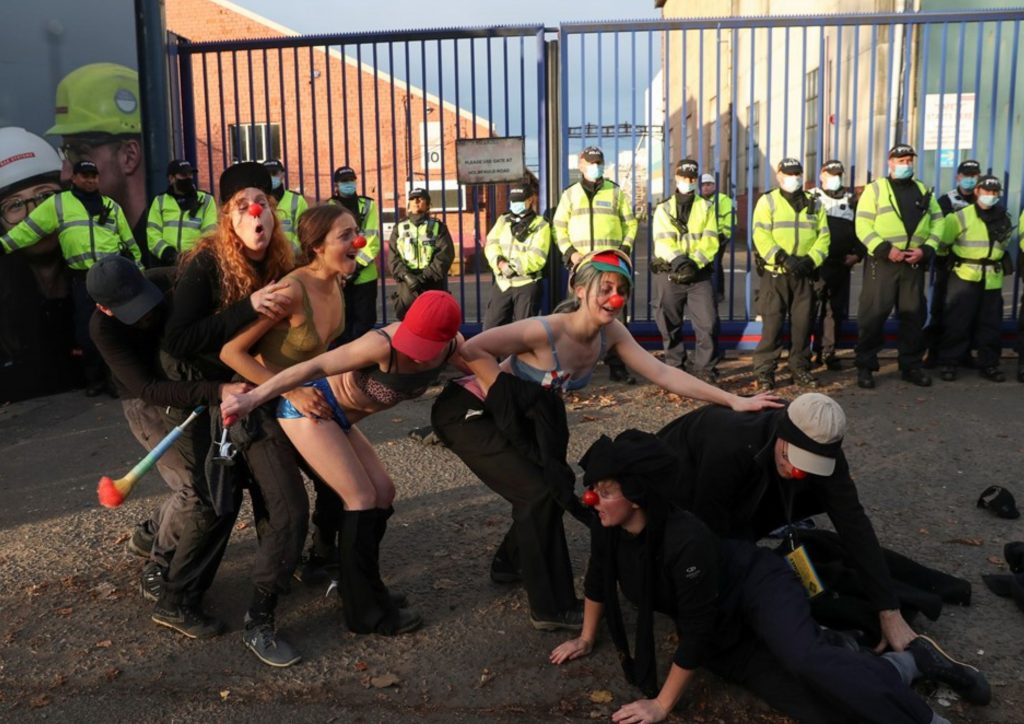
Confusion rather than Confrontation
A key tactic of the Clown Army was to confuse rather than disrupt. Dressed as the army, they placed themselves ‘with’ the authority with hilarious and disruptive results. In one incident, a simple instruction from the police, ‘Stand behind the line!’ (meaning behind road markings) descended into chaos as the clowns attempted to interpret what ‘the line’ meant. The phrase was also repeated so many times, by so many clowns, that it became meaningless and ineffective.
I like to explore the concept of confusion with workshop participants by playing with status and authority. We explore status through the body. In pairs, each takes turns being the boss getting their partner to do what they want just through posture and eyes. This quickly reveals who likes to be in charge and who likes to follow. I create teams of bosses and workers given the task to prepare the room for an important dignitary’s arrival. One group prepares the seating, another creates the welcome ceremony and another ensures the event security. With a countdown to the arrival, the teams work quickly and generally well. I break the bad news that there’s been a change of plans and the event has been cancelled. We stop and reflect. How were the work teams? Bosses generally look pretty smug, claim their teams worked well and they were happy with the results.
Next I talk about the concept of ‘malicious compliance’, a term coined by activist-artist Sophie Miller of Ocean Rebellion. It is the idea of obeying authority – but in an obstructive way. How we do this can be varied. To explore the possibilities I now give the working teams permission to ‘obstruct the process’ in a clown way. A new dignitary is on their way and teams get to work. The room erupts into chaos as I observe the wildly funny results. Some are going slow or sneaking off for naps, others misunderstand instructions or take them too literally, while some clowns find over-complicated or absurd solutions to laying out chairs that end up in a precarious tower in the middle of the room. The bosses look haggard after this version, like they’ve experienced a day of dealing with wild primary school children. We reflect on this exercise. It is also a chance to talk about using tactics like this when dealing with police in protests. This type of provocative work is not for everyone and it might not suit all situations so it usually makes for an interesting debate.
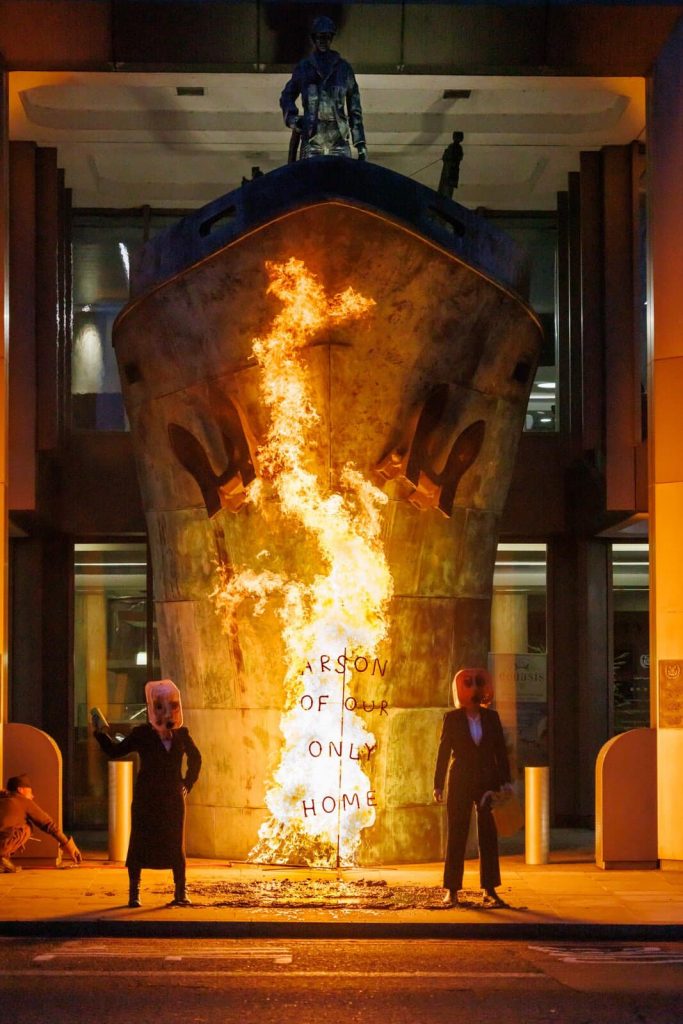
Imagining Utopian Futures with Clown Logic
It can be hard to imagine a positive future. Some say the climate crisis is a crisis of the imagination. But could the clown offer tools for creating new and compelling narratives of the future? Using clown logic can help us to think differently about problems, reveal hidden solutions and dare us to dream of systematic change.
I use the ‘yes and…’ storytelling game. In pairs one person begins: ‘Let’s go to the beach.’ The other says, ‘Yes, we’ll go to the beach and we’ll buy ice-cream’. ‘Yes, we’ll buy ice-cream and we’ll feed it to the seagulls’, etc. It is important that the story develops on the idea suggested before. I also encourage participants to stand up and get their whole body involved in the storytelling. This exercise builds complicity and with the affirmation of your partner can develop in wild and absurd ways. I have also used this exercise to bring clown imagination to action design. So we begin, ‘Let’s go to the protest’, ‘Yes, we’ll go to the protest and pretend to be police’, ‘Yes, we’ll pretend to be police and apologise to all the protesters for being so mean’, etc. Once the exercise is over, I ask participants to recall their favourite parts of the action. In there are potentially magical ideas that would never have been conceived with our logic. Somewhere in there, those utopian solutions might also exist. Or at least in our imagination these beautiful, new worlds are possible.
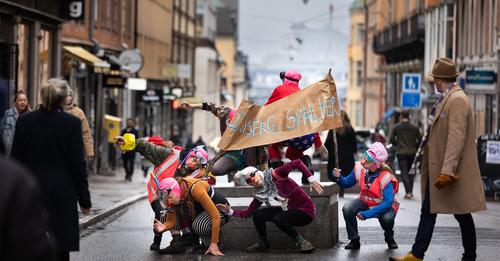
What now?
I am researching clowning in the Anthropocene. I love the term ‘research’. It gives me permission to not know, to be curious, to try things, to fail, and to play. Not surprisingly, these are the same modes of operating as a clown. So I guess I’m a clown researcher, doubling down on trying to figure it all out. And here we are in the time in which humans are the most influential species on the planet, causing significant global warming and changes to the environment. Not to mention the political and social shifts we are constantly facing. I need to contribute to building resilience for the crises we face ahead; to finding solutions, and inspiring hope. These are some of my projects that take steps to do this:
I am standing in a circle with clowns, academics, performers, artists and activists. We are collectively asking, ‘what does it mean to be a clown in this current era?’ This is the first Clown Congress – a four-day gathering in Bristol, UK. An inspiring mix of workshops, presentations, open space sessions, dancing, playing and shared meals provide opportunities to connect and envision the future of clowning in these turbulent times.
I am sheltering from the rain while watching clowns take an absurd census on the streets of Stockholm. ‘Do you want to be counted? How many are you?’ asks one with a giant pencil. These clowns are here to help the government carry out their census of every single person in Sweden. This is an action created by participants of the Nomadic Rebel Clown Academy – a five-day workshop exploring the meeting point of clowning and activism, created in collaboration with Clown Army co-founder, Hilary Ramsden. This clown action responds to the far-right policy aimed at reducing the number of ‘illegal’ people in the country, one of an increasing number of fascist policies being pushed through by a party that is not even in power. The action playfully yet pointedly highlights the absurdity of the policy.
I am stuffing my clothes with pillows to create a belly, knobbly knees and a big bum. Elsewhere in the room other women are also stuffing, moving, and enjoying their new grotesquely distorted bodies. This is the Laboratory of the Un-beautiful, an exciting collaboration with feminist theatre maker Deborah Bard Antoinette using bouffon to explore the female experience. In a playful improvisation we explore the internalised voice of the patriarchy; ‘I’m sorry!’, ‘No, no, it’s me!’, ‘No, it was my fault, I’m just taking up too much space’. Parody, pleasure and play are integral to this political theatre form, allowing us to rip up social prescriptions and dismantle patriarchal forces. The process is wildly funny and transformative.
In these projects and more I am deepening my understanding of the political possibilities of clowning. My research weaves in my experiences, the threads of ritual and of participatory street theatre. It gives me a framework to share clowning with others, in workshops, in the streets and in protests. And it plays a part in creating the clown revolution that the world so desperately needs right now.
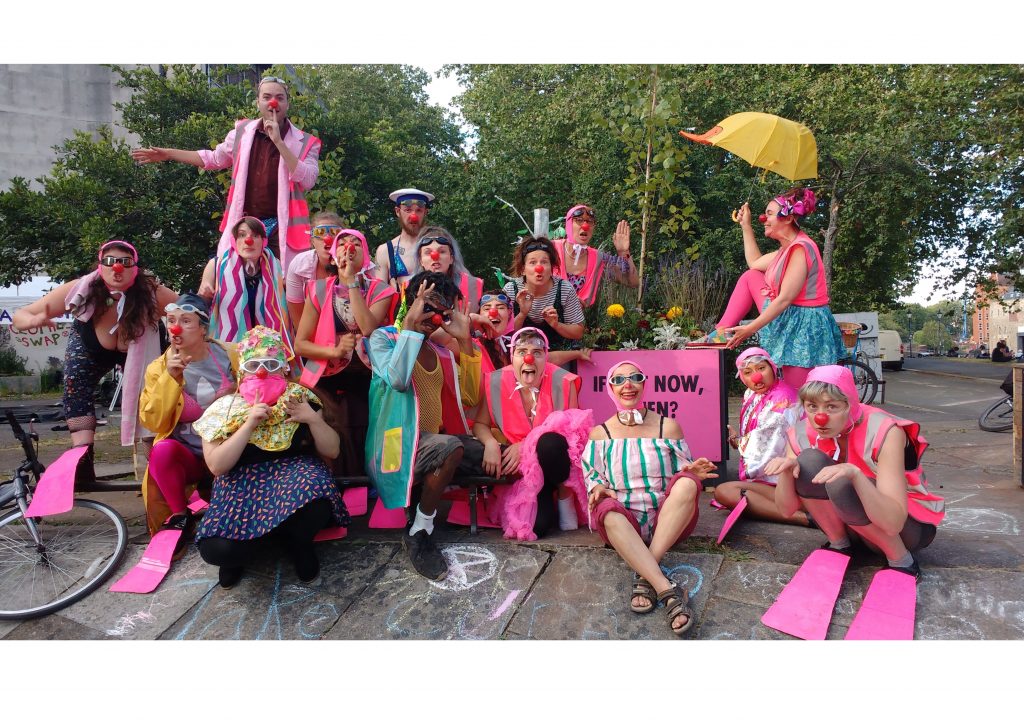
Featured image (top of page): Cop Clowns at Cop26. Photo Rhiannon Redpath.
Robyn Hambrook is a Bristol-based director, teacher and performer. With over 20 years experience, she is a passionate practitioner of clowning, physical theatre, circus and street arts. She has a MA in Circus Directing, a Diploma of Physical Theatre Practice and trained with a long line of inspiring teachers including Holly Stoppit, Peta Lily, Giovanni Fusetti, Jon Davison, Zuma Puma and Deanna Fleysha.
Robyn has performed with many acclaimed physical theatre companies including, Derevo, Akhe, Oceanallover, and Gappad as well as her own award-winning company, Fun in the Oven Theatre. In 2020, Robyn set up The Online Clown Academy with Holly Stoppit and developed a series of Zoom Clown Courses. Robyn’s research, started during her Masters, has been exploring the meeting point of clowning and activism – online, in the real world and with international collaborators.
www.robynhambrook.com | Facebook @Robyn Hambrook | Instagram @robynonfire13
Circomedia is a school for contemporary circus and physical theatre based in Bristol, England. They offer a variety of training courses and workshops that teach circus skills in the context of physical theatre, performance, and creativity. Alongside this, they also present 36 professional circus, theatre and dance shows a year.Their courses include circus BTEC, Degree and Masters courses; alongside part-time classes for circus practitioners of all levels, and a range of community outreach projects.
The Clandestine Insurgent Rebel Clown Army (also known as CIRCA and Clown Army is an anti-authoritarian left-wing activist group that uses clowning and non-violent tactics to act against corporate globalisation, war, and on other issues. The group originated circa 2003 in the United Kingdom. Further information can be found at:
https://en.wikipedia.org/wiki/Clandestine_Insurgent_Rebel_Clown_Army
https://beautifultrouble.org/toolbox/tool/clandestine-insurgent-rebel-clown-army/
http://www.tacticalmediafiles.net/articles/3546/Clandestine-Insurgent-Rebel-Clown-Army-Manifesto
This article was written by Robyn Hambrook as part of a mentoring programme funded by Arts Council England’s Developing Your Creative Practice


